
Posted on 04/13/2003 10:01:57 AM PDT by Alissa
Brad Borst remembers that infamous day 10 years ago in more detail than he'd like.

He was a 19-year-old construction worker, helping to build the new Denver airport. At the end of his workday, riding a bus that took crews to a parking lot, he heard co-workers chatting.
"They were kind of joking around, saying something like, 'Did you hear that they burned up those religious fanatics?'"
Borst tensed, but kept mum.
As soon as he reached his car, he switched on the radio. That's how he learned his mother was dead.
The afternoon was April 19, 1993. Hours earlier, David Koresh and 75 followers had died at their rambling wooden residence outside Waco called Mount Carmel. Some had been shot; most died from burns.
Borst's mother, Mary Jean, 49, had been a Koresh follower. Brad had been raised at Mount Carmel, but because he disagreed with doctrines taught there, had left several months earlier.
"A few weeks after I turned 18, I went to see David and told him that I was leaving," said Borst, who now works as a police officer. "He gave me $50 and got me a ride to the bus station."
Today, from his home in Colorado, Borst is petitioning Congress to investigate his mother's death, because in the aftermath of the Mount Carmel tragedy he was convinced the Koresh faithful did not kill themselves, as official reports claim.
"There's no doubt in my mind that somebody turned and started shooting, but I knew the people inside, and they wouldn't have done anything like that. David taught against suicide," he said.
Two congressional hearings and a special investigative commission have found the FBI fired no shots during the siege, and Borst is aware there's little chance of a new airing of the Waco controversy.
His desperation and suspicions are typical of survivors of Mount Carmel, but they come from a page of history that, veterans on both sides of the conflict note, rapidly is being forgotten.
51 days
About 10 miles northeast of Waco, a gravel driveway leads into a 77-acre ranch where no cattle roam. Down the driveway about 100 yards is a wooden chapel where surviving Koresh followers — "Davidians," as they are publicly known — hold weekly worship services. The chapel, built in 2000, sits over the spot where the twin front doors of Mount Carmel stood.
About 9:30 a.m. on Feb. 28, 1993, gunfire broke out at the site. Agents from the U.S. Bureau of Alcohol, Tobacco and Firearms dismounted from cattle trailers and rushed the doors, trying to serve a search warrant. Koresh and his lieutenants, the ATF believed, were hiding automatic weapons and grenades.
The raiding agents swore the first shots came from inside the building, but Mount Carmel's residents claimed the ATF had charged the doors with guns blazing.
Because lawsuits challenging the ATF raid still are making their way through the courts, the agency refuses to allow its agents to comment on the affair. But former agent Robert White, now a sheriff's deputy in Hunt County, said he's sure the Davidians fired first.
"By the time I got out of that trailer, 200 to 300 rounds had already been fired," said White, who was shot twice during the fracas. "When they told Koresh that they were federal agents, as soon as he shut the door, the shooting started."
A 45-minute gunbattle ensued, killing five Mount Carmel residents and four ATF agents. As the ATF force retreated, a team of snipers from the ATF and Texas Rangers killed a sixth Davidian in a pasture not far away.
The ATF raiders were reinforced overnight by more than 300 FBI officers, who cordoned the area around Mount Carmel and brought in armored vehicles from nearby Fort Hood. The sky over Mount Carmel was declared a no-fly zone.
Teams of negotiators talked by phone night and day with the inhabitants of Mount Carmel, including Koresh, who was severely wounded. Their chats resulted in the surrender of 37 of Mount Carmel's 120 inhabitants to the FBI.
At sunrise April 19, FBI commanders ordered tank crews to bring the standoff to an end. Their tanks fired more than 400 tear gas grenades into hallways and rooms. Tank drivers also knocked large holes in the building, to create exit routes, the agency said.
Residents answered with small arms fire.
Just after noon, Mount Carmel went ablaze. It soon was a mountain of cinders and blackened wood. Nine people, all adults, escaped the flames.
From the ruins investigators salvaged the charred remains of 76 people, 18 of them children under 10.
In the wake of the carnage, a few congressmen and pundits called for the resignation of Attorney General Janet Reno. But President Clinton defended her, declaring Koresh "killed those he controlled."
Reno and the Justice Department were not at fault, Clinton said, "because some religious fanatics murdered themselves."
But Koresh's followers denied responsibility.
"No one inside set any fires. There were no plans for suicide," declared Renos Avraam, one of the survivors of the blaze.
Nine months after the inferno, a jury trial for 11 Davidians accused in the affair opened at the federal courthouse in San Antonio. It lasted 49 days.
Three of the defendants were acquitted of all charges. None was found guilty of murder, but eight were sentenced to prison terms of five to 40 years for manslaughter and gun law violations.
Though the U.S. Supreme Court in 2000 ordered reductions in the sentences, seven of the Davidians remain in prison today.
Patriots, militias
The gunfight at Mount Carmel was preceded in August 1992 by a shootout near Ruby Ridge, Idaho. U.S. Marshal William Degan, 42, and the 13-year-old son of white separatist Randy Weaver were killed.
During the standoff that followed, FBI sniper Lon Horiuchi killed Weaver's wife, Vickie.
The Ruby Ridge affair gave impetus to a gathering movement of tax protesters and gun-rights advocates who billed themselves as "Patriots." After the Mount Carmel standoff, the Patriot movement began to organize self-defense groups it called "militias."
"Remember Waco!" became the militias' rallying cry.
On April 19, 1995, the second anniversary of the Mount Carmel fire, a bomb exploded at the Alfred Murrah Federal Building in Oklahoma City, killing 168, including 19 children.
Middle East terrorists at first were suspected in the blast. But within days, two Americans who had been fringe participants in the militia movement, Timothy McVeigh and Terry Nichols, were in jail, and in 1997, they were convicted in separate trials. McVeigh was executed.
While criminal cases against the pair were pending, a film, "Waco: The Rules of Engagement," drew new audiences to the Mount Carmel controversy, and new supporters for the militia cause.
The documentary, researched by Michael McNulty, a Colorado novice to filmmaking, premiered at the prestigious Sundance Festival in 1997, was nominated for an Academy Award in 1997 and won television's Emmy award for best work of investigative journalism in 1999.
"It took the story of Waco out of the hands of the government and media, and put it in the language of people," McNulty said.
At its heart was a new claim, made by former Defense Department personnel, that an aerial infrared film of Mount Carmel made during the April 19 assault showed flashes of gunfire from FBI lines.
"Rules" and two lesser-known successor movies, said Brad Borst, convinced him that his mother and other Davidians had been slain by federal agents.
Though the movies gave a second wind to Waco critics, most observers say the militia movement began to decline soon after the Oklahoma City blast. In the wake of the bombing, too, federal law enforcement officers called on militia leaders and visited their meetings.
"Law enforcement attention encouraged the militias to chose between reform and revolution," said Chip Berlet, who follows right-wing movements for Political Research Associates, a Boston think tank.
"By our reckoning, the militia movement peaked in 1996, with 856 groups. By our count, it now has only 143," said Mark Potok of the Southern Poverty Law Center, which keeps tabs on right-wing organizations.
A new approach
Despite the passing of the militia movement, the Mount Carmel affair influenced the way in which American law enforcement agencies deal with groups of determined opponents, federal law enforcers say.
The change was evident in two post-Waco standoffs: with the Montana Freemen in 1996, and, closer to home, with leaders of the Republic of Texas movement, near Fort Davis in 1997.
On March 25, 1996, FBI agents approached a farmhouse near Jordan, Mont., where a group of Freemen had gathered. The agents carried warrants for the arrest of 10 of them. When the suspects wouldn't surrender, the agents cordoned the area.
They then implemented a milder strategy than that used at Waco.
They wore civilian clothes, not combat gear, and they kept armored vehicles out of sight. In Waco, the FBI had held daily televised news conferences, a practice that, some observers believe, created public pressures to end the standoff in a dramatic way. News conferences were not a feature of the Montana siege.
Perhaps most important, the agents allowed phone calls and visits by relatives of the holed-up Freemen. Many of the relatives pleaded with their kin to surrender. At Waco, more than a dozen relatives of the residents, including Jean Holub, Koresh's paternal grandmother, were denied both phone and personal access.
On June 13 — 81 days after the Freemen standoff began — the remaining 16 holdouts surrendered. No shots were fired, no chemical weapons were used and no one died on either side of the barricades.
FBI Director Louis Freeh credited "a fundamentally different approach" by the bureau, one that, he said, "put patience above the risk of bloodshed.
"A strategy from Day 1 of patient, honest and persistent attempts at negotiation ultimately prevailed," he said.
A similar conclusion resulted from the last of the political and religious standoffs of the '90s, the May 1997 confrontation with members of the Republic of Texas movement. A low-key approach by state troopers and Texas Rangers, with advice from FBI veterans, brought quick results: Within seven days, the Republic's leaders had surrendered.
Two members fled into the wilds, one of whom was killed in an exchange of gunfire with DPS officers. Nevertheless, the operation was roundly deemed a success.
"The DPS was certainly conscious of what had happened at Waco, and was extremely interested that something like that not happen again," said Mike Cox, the agency's press spokesman at the time. "Texas showed the world how it should be done."
From the Freemen and Republic of Texas standoffs, former FBI negotiator Clint Van Zandt said, law enforcement planners learned that "the talking cure works."
"The phoenix that came out of the ashes of Waco," he said, "is a new approach."
Unchanged faith
Most people have put the Mount Carmel tragedy behind them, and even the surviving Davidians now are looking toward the future.
Larry Lynch, a former deputy who negotiated with Koresh by phone during the Feb. 28 gunfight, now is sheriff of McLennan County, whose seat is Waco. The Mount Carmel episode put Waco on the map, he said, but didn't have a lasting negative effect on the city.
"The only thing is, you don't have to say 'Texas' after you say 'Waco' anymore," he said.
Though a few believers have died, and a few have fallen away, a core of some three dozen Davidians has kept the faith, which, members say, gives them hope for the future.
"I don't anticipate our serving out the time that remains," writes Davidian prisoner Livingstone Fagan, 43, whose wife and mother died in the April 19 fire.
Fagan is the last of the Davidians slated for release, in 2007; the six others are to be released in 2006.
"There are surprises yet to reveal themselves in the prophetic timetable of events," he suggests.
The "surprises" to which he refers include the return in the sky of David Koresh, notes Clive Doyle, 62, one of those who was exonerated in the 1994 San Antonio trial.
"David predicted that he'd come back in a somewhat different form," he said, "and even though all of my life I've expected things too soon, we still believe that it won't be long."
Yeah, when we find the missing videos of the original raid, the missing right-hand door with all the 9mm ingoing holes, the ID of the Delta Force operator that blasted the hole in the 6" thick roof of the concrete pantry/"bunker" where the bodies of many of the women and kids were found, ...........when pigs fly.
regards,
In _Jim's world pigs fly on the hour every hour

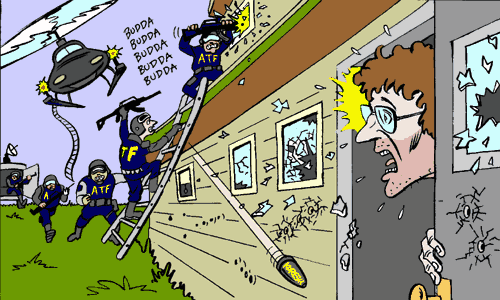
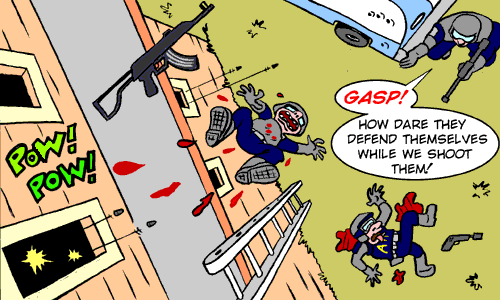
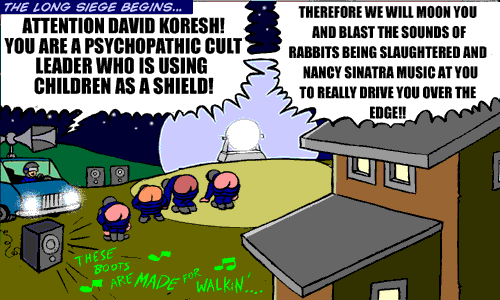
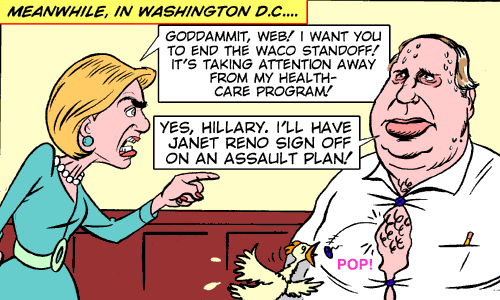
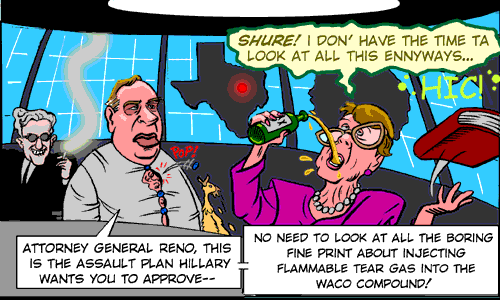
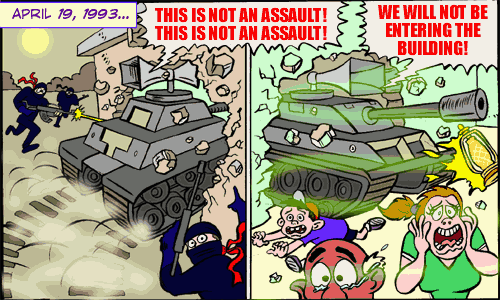
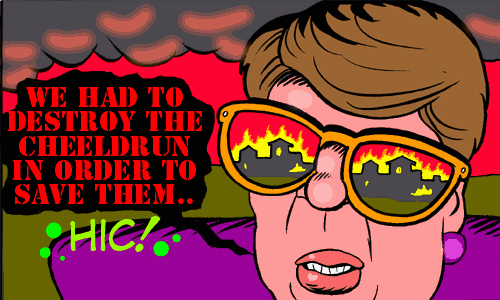
L. TRIPP: Let me relay a little story to set this up. Vince Foster... was dignified, decent, caring, smart. When Waco happened, that's when I first knew that Vince was falling apart.
A blast from the past.......can't seem to get the OTHER April 19th American tragedy off my mind today.
Disclaimer: Opinions posted on Free Republic are those of the individual posters and do not necessarily represent the opinion of Free Republic or its management. All materials posted herein are protected by copyright law and the exemption for fair use of copyrighted works.